Oct-25-18
 | | KEG: Going into the Munich 1900 tournament, Schlechter was often called the "drawing master." He lived up to this nick-name in the first two rounds, taking draws in positions in which he had excellent winning chances. But then he went on a winning streak, winning his next three games. In this contest with Wolf, Schlechter arrived at a seemingly drawn Bishops-of-opposite- colors ending. But then, belying his reputation, Schlechter played fine excellent aggressive chess and completely blew away Wolf by exploiting seemingly small errors. After achieving a clearly won endgame, Schlechter weakened between moves 38 and 42 (perhaps because of time pressure) and gave Wolf a glimmer of hope, but then settled down and finished off the contest nicely. With this win, Schlechter brought his record in this tournament to 5-1, passed Maroczy (who had been in first but lost to Berger in this round) and moved into a three-way tie for first place after six rounds with Pillsbury and Marco. 1. e4 e5
2. Nf3 Nc6
3. Bg5 a6
4. BxN
Wolf tries the Exchange Variation of the Ruy Lopez, perhaps hoping for a draw against the so-called "drawing master." But as will be seen, Schlechter was not looking for a draw in this game. 4... dxB
5. Nc3
5. 0-0 is more usual and perhaps best, but the text is a solid line that is fine if White seeks only equality. In his famous game against Capablanca in 1914, Lasker here played 5. d4. 5... Bc5
More aggressive than the normal 5...f6 (which may well have been the move Wolf had anticipated from Schlechter). 6. d3
Wolf continues his cautious play. 6. Nxe5 or 6. Ne2 are better options if White is playing for a win. In any case, chances remain about even. 6... f6
"!"--Tournament Book.
The text is fine, but I fail to see why the Tournament Book assigned "!" to this fairly normal-looking move. 7. Qe2
More hyper-cautious play by Wolf, probably planning to swap Bishops via a later Be3. 7. 0-0, 7. a3, and 6. Na4 all look more enterprising, though the text doesn't give anything away. 7... Bg4
This winds up being a loss of time that gives away any even small advantage Schlechter may have enjoyed as a result of Wolf's passive play. 7...Ne7 or 7...Bd6 were better. 8. h3 Bh5
9. Be3 Bb4
9...Bd4 was stronger.
10. a3
More passive play by Wolf. 10. 0-0 or 10. Rd1 would have given him better prospects of seeking the advantage. 10... BxN(c3)+
11. bxB Qd6
12. 0-0 Ne7
13. Rfb1 b6
The position was now:
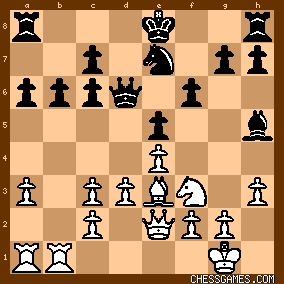
click for larger viewChances were about even at this stage. Both sides have doubled c-pawns. Wolf's King-side pawn formation is broken, but he controls what there is of the b-file. 14. a4
"?"--(Tournament Book).
I agree that 14. d4 or 14. Re1 may have been marginally better, but I see nothing terribly wrong with the text (though it accomplishes very little for White). 14... a5
"!" -- (Tournament Book).
Schlechter puts an end to any notion Wolf may have had of playing a5. 15. d4 0-0
16. Qc4+ Bf7
The simple 16...Kh8 was probably best. But Schlechter still had a decent position after the text. 17. dxe5 fxe5
18. Qd3
"!"--(Tournament Book).
Wolf decides to seek a draw in the resulting endgame. 18... QxQ
Schlechter should probably have avoided the endgame with 18...Qf6, after which he would have had the better game. But Schlechter may well have concluded that he would face no risks in the ending and might have chances to attack Wolf's weak King-side pawns. In any event, the trade of Queens gives us a chance to see Schlechter's endgame precision in action. 19. cxQ Ng6
20. d4 Rfe8
This left:
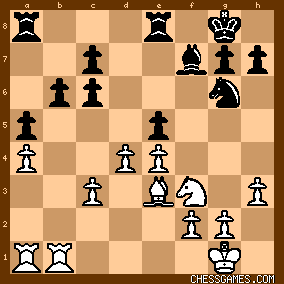
click for larger viewWolf may have relied on the potentially equalizing effect of Bishops-of-opposite colors. Indeed, any advantage here seems to lie with White. But from here, as I will discuss in my next post on this game, Wolf sought further exchanges (trading Knights on move 22) and then--just when he may have thought the game was about to be drawn--got completely outplayed by Schlechter, who had a clearly won ending in fewer than ten moves. |
|
Oct-25-18
 | | KEG: Post II
21. dxe5
21. Nd2 was Wolf's only plausible way to play for an advantage. But he still seems happy to reach a peaceful conclusion in this game. Schlechter, as will soon be seen, would have none of this. 21... Nex5
Schlechter could also have delayed this recapture and played for complications with 21...c5 or 21...h6. But as will be seen, Schlechter has other ideas about how to attack Wolf's position. 22. NxN RxN
This left:

click for larger viewIs this just a draw? Stay tuned.
23. f3 Re7
24. Kf2
"?"--(Tournament Book).
While 23. Rd1 or 23. Bg5 may have been somewhat better, I see nothing much wrong with the text, which had nothing to do with Wolf's loss. 24... Rd7
25. Rb2 Bc4
The position was now:
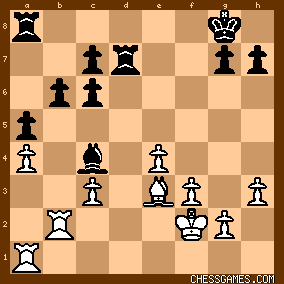
click for larger viewThe game is still about even. White has a passed e-pawn, but also has weak pawns on the Queen-side which Schlechter no doubt hoped to be able to exploit. But here Wolf decided to create some play for his passed e-pawn, and got crushed immediately by Schlechter. 26. f4?
Wolf had many non-committal moves that should have given him chances to hold the balance (e.g., 26. Kg3, 26. h4, 26. Rd2, and even 26. Rbb1. After the text, we are treated to an exhibition of Schlechter's splendid end-game technique. 26... Re8
"!"--(Tournament Book).
27. e5
After his 26. f4?, Wolf has little choice.
27... Rd3

click for larger viewNote hos drastically the position has swung in Schlechter's favor over the course of the last two moves. From here, Wolf only made matters worse for himself, and Schlechter's precise play gave him a clearly won position within another couple of moves. 28. Rc2
An awful way to defend the c-oawn. If Wolf was set on protecting the pawn, he should have played 28. Rc1 or 28. Ra3 both would have been less passive. Alternatively, Wolf could have given up on the c-pawn and gone in for King-side counterchances. 28... Kf7!
Schlechter has a devastating attack in mind, but as will be seen shortly the text is essential for his plans. 29. Kf3?
As Schlechter quickly shows, this move is drastically inferior to 29. Kg3 since it allows 31...Bd5+. 29... g5!
Schlechter's attack begins in earnest. As I will discuss in my next post on this game, Wolf from this point had no viable defense, the position now being: 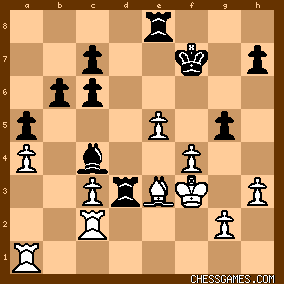
click for larger view |
|
Oct-25-18
 | | KEG: Addendum to Post I
In my comment after Schlechter's 13th move, I referred to Wolf's broken King-side pawn formation. I of course meant to speak of Wolf's broken Queen-side pawn formation. |
|
Oct-25-18
 | | KEG: Post III
One further correction. My comment on Wolf's 29th move contained a horrendous typo. I meant to suggest 29. g3, and not 29. Kg3?? which hangs a piece. (29. Ra3 would also have been much better than 29. Kf3?) Returning to the game:
30. g3
Yet another weakening move by Wolf, which was promptly punished by Schlechter. 30... gxf4
31. gxf4 Bd5+
This is the brutal check that Wolf's poor 29th move allowed and which essentially ended the game, the position now being: 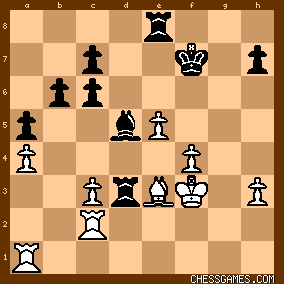
click for larger view32. Ke2
An unhappy necessity, since 32. Kf2? would get crushed by 32...Rg8! 32... Be4!
Schlechter's endgame precision is wonderful.
33. Rd2
Reasonably deciding to abandon the c-pawn and seek counterplay. Schlechter's advantage at this point, however, was too great for any such heroics to have had any real prospects of success. 33... Rxc3
Allowing Wolf some play on the d-file but picking up the loose pawn. 34. Rd4
Weak. Come what may, Wolf had to try either 34. Rd7+ or 34. Rg1 and attempt to muster up an attack, or trade down to the point that Bishops of opposite colors might give him some drawing chances. 34... Bf5!
Both defending the Bishop and gaining time by attacking Wolf's weak h-pawn. 35. h4
Wolf continues to flounder. The best counters to Schlechter's last move were either 35. Rc1 indirectly threatening the Black c6 pawn; 35. Rdd1 (preparing to counter Bxh3 with Rh1; or 35. Rg1. Now Schlechter seizes the g-file and the game is as good as over. 35... Rg8!
35...c5 would also have been a killer.
36. Rh1?
Wolf seems resigned to his fate. 36. Rc1, or 36. Kf2 or 36. e6+ would have at least allowed him to resist for a while. After the text, the sorry plight of Wolf was apparent: 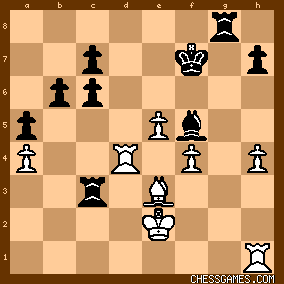
click for larger view36... c5!
37. Rd2 Rg3!
Wolf was clearly busted at this point:
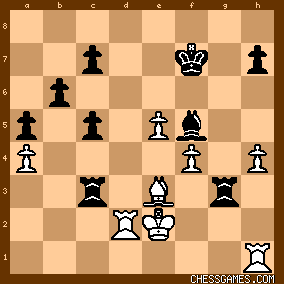
click for larger view38. Bf2 Bg4+
39. Kf1 Rc1+
40. Be1
This left:
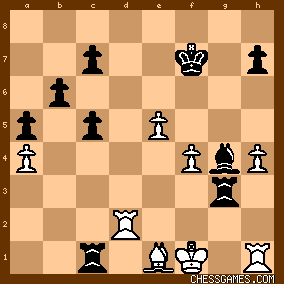
click for larger viewThe game sure looks as good as over. But from here, Schlechter--perhaps because of time pressure (there was a move 45 time control) became less precise for the next few moves and--as I will discuss in my next post on this game--almost seemed to let Wolf back in the game before finally finishing him off. |
|
Oct-26-18
 | | KEG: Post IV
40... Re3
This did not imperil Schlechter's win, but 40...c4 would have been a faster route to finishing off Wolf. 41. Kf2 Rd3+
It appears that Schlechter was trying to meet the 45-move time control. Otherwise, 41...Re4 was best. 42. Kg2 Rxf4
Winning a second pawn may have looked superficially best, but far more forceful would have been 42...Rcc3; 42...c4; 42...Ke6; or 42...Ra3. After this second-best move by Schlechter, the position was: 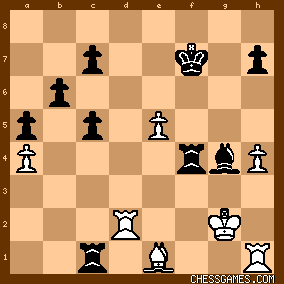
click for larger viewWolf now had his last chance to generate chances with 43. Bg3. Instead, he wimped out with: 43. Rg1 Ke6
This was plenty good, though Schlechter could just have picked up a third pawn with43...Rxa4. 44. Bg3
If Wolf really wanted to play on, he should have played 44. Ra2. From here, Schlechter cleaned up: 44... RxR+
45. KxR Rxa4
This left:
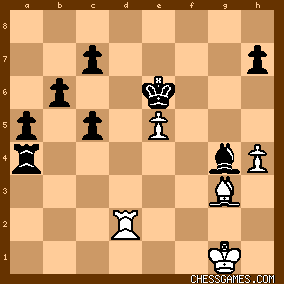
click for larger viewWolf could have safely spared himself what followed: 46. Rd8 Re4
47. Re8+
This only drove Schlechter's king to a safe haven,leaving no play for Wolf at all. 47... Kd7
48. Rg8 h5
49. Rg7+ Kc6
50. Rg6+ Kb7
51. Rg7 a4
0-1
The final position was:
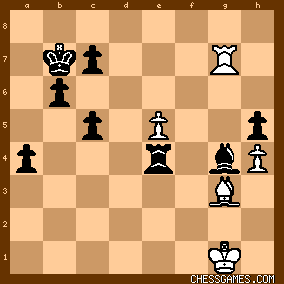
click for larger viewSchlechter's victory in this endgame and zeal for victory in a game with approximately even chances showed that he was moving past being just a "drawing master." |
|
|
|
|





































